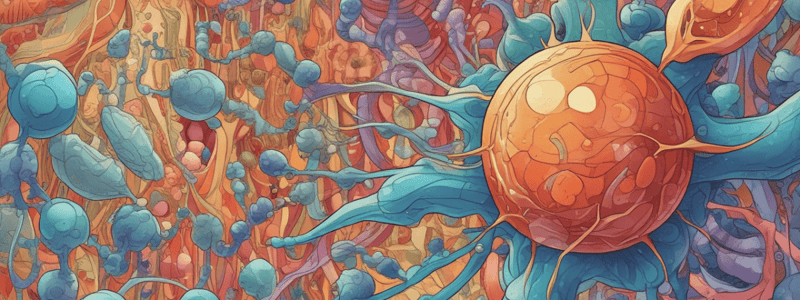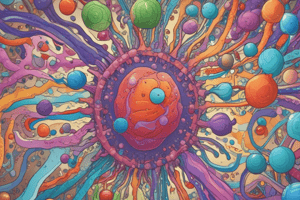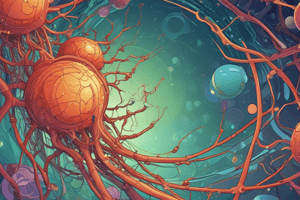Podcast
Questions and Answers
What is the term for the immune response to a harmless molecule that leads to tissue damage and even death?
What is the term for the immune response to a harmless molecule that leads to tissue damage and even death?
- Immunodeficiency
- Hypersensitivity (correct)
- Adaptive immunity
- Autoimmunity
What is the percentage of the population that suffers from atopy, an inherited tendency to make immediate hypersensitivity responses?
What is the percentage of the population that suffers from atopy, an inherited tendency to make immediate hypersensitivity responses?
- 20-30%
- 10-20%
- 50-70%
- 30-50% (correct)
Which type of immune response is mediated by IgE, mast cells, and Th2 responses?
Which type of immune response is mediated by IgE, mast cells, and Th2 responses?
- Delayed hypersensitivity
- Immediate hypersensitivity (correct)
- Immunodeficient response
- Autoimmune response
What is the name of the cells that play a crucial role in the immediate hypersensitivity response?
What is the name of the cells that play a crucial role in the immediate hypersensitivity response?
What is the term for the harmless molecule that initiates an immune response in some people?
What is the term for the harmless molecule that initiates an immune response in some people?
What is the physical manifestation of the immediate hypersensitivity response when it occurs in the skin?
What is the physical manifestation of the immediate hypersensitivity response when it occurs in the skin?
What is the link between anti-IgG and a specific autoimmune disease?
What is the link between anti-IgG and a specific autoimmune disease?
Which of the following autoimmune diseases is linked to anti-myeloperoxidase or proteinase 3?
Which of the following autoimmune diseases is linked to anti-myeloperoxidase or proteinase 3?
What is an example of IgG mediated pathology?
What is an example of IgG mediated pathology?
Which of the following is not an example of an autoimmune disease?
Which of the following is not an example of an autoimmune disease?
What is a proof of autoimmunity?
What is a proof of autoimmunity?
Which of the following autoimmune diseases is linked to anti-thyroid stimulating hormone receptor?
Which of the following autoimmune diseases is linked to anti-thyroid stimulating hormone receptor?
What is the primary mechanism by which thyroxine production is regulated?
What is the primary mechanism by which thyroxine production is regulated?
What is the effect of TSH binding to the TSH receptor?
What is the effect of TSH binding to the TSH receptor?
What is a characteristic of Graves' disease?
What is a characteristic of Graves' disease?
When was the discovery of anti-thyroid autoantibodies made?
When was the discovery of anti-thyroid autoantibodies made?
What is the relationship between the pituitary gland and the thyroid gland?
What is the relationship between the pituitary gland and the thyroid gland?
What is the effect of Graves' disease on the body?
What is the effect of Graves' disease on the body?
What is the primary cause of primary immunodeficiencies?
What is the primary cause of primary immunodeficiencies?
Which T cell subtype is characterized by the production of pro-inflammatory cytokines?
Which T cell subtype is characterized by the production of pro-inflammatory cytokines?
In the context of T cell function, what is the role of Regulatory T cells (Treg)?
In the context of T cell function, what is the role of Regulatory T cells (Treg)?
Which cell type directly develops from myeloid lineage precursors?
Which cell type directly develops from myeloid lineage precursors?
What is the likely outcome when Treg cells fail to suppress other T cells?
What is the likely outcome when Treg cells fail to suppress other T cells?
Which of the following is a feature of secondary immunodeficiencies?
Which of the following is a feature of secondary immunodeficiencies?
What is the origin of pre-T cells in the development of T lymphocytes?
What is the origin of pre-T cells in the development of T lymphocytes?
Which cell type is involved in the defense against viral infections and tumors?
Which cell type is involved in the defense against viral infections and tumors?
What is the primary mechanism by which monoclonal anti-IL-17 therapy for psoriasis can lead to severe systemic fungal infections?
What is the primary mechanism by which monoclonal anti-IL-17 therapy for psoriasis can lead to severe systemic fungal infections?
What is the primary reason behind the increased susceptibility to cancer in individuals with a compromised immune system?
What is the primary reason behind the increased susceptibility to cancer in individuals with a compromised immune system?
How does the PD-1/PD-L1 interaction contribute to cancer development?
How does the PD-1/PD-L1 interaction contribute to cancer development?
What is the underlying mechanism for the development of post-transplant lymphoproliferative disease (PTLD)?
What is the underlying mechanism for the development of post-transplant lymphoproliferative disease (PTLD)?
How does the immune system normally control Epstein-Barr virus (EBV) infection?
How does the immune system normally control Epstein-Barr virus (EBV) infection?
What is the main reason why individuals with immunodeficiency are more susceptible to infections?
What is the main reason why individuals with immunodeficiency are more susceptible to infections?
Flashcards are hidden until you start studying
Study Notes
Immune System Gone Wrong
- The immune system protects us from microbes, viruses, parasites, and other harmful substances.
Hypersensitivity
- Hypersensitivity is an immune response to a harmless molecule, leading to tissue damage and even death in some people.
- Immediate hypersensitivity is also known as an allergy, mediated by IgE, mast cells, and Th2 responses.
- Atopy is an inherited tendency to make immediate hypersensitivity responses, affecting 30-50% of the population.
Autoimmunity
- Autoimmunity occurs when the immune system attacks the body's own cells and tissues.
- Examples of autoantibodies and their associated diseases:
- Rheumatoid factors (anti-IgG) - Rheumatoid arthritis
- Anti-citrullinated peptide - Rheumatoid arthritis
- Anti-DNA and nucleoprotein - Systemic Lupus Erythematosus (SLE)
- Anti-myeloperoxidase or proteinase 3 - Autoimmune vasculitis
- Anti-islet cell antibodies and antibodies to insulin, GAD65, IA-2, ZnT8 - Type I diabetes
- Anti-myelin basic protein - Multiple sclerosis
- Anti-thyroid stimulating hormone receptor - Graves' disease
- Anti-acetylcholine receptor - Myasthenia gravis
- Proof of autoimmunity can be shown through passive transfer of disease by immune effectors (e.g., T cells, antibodies) or clinical responsiveness to immune suppression or re-establishment of tolerance.
Autoimmune Diseases
- Examples of autoimmune diseases:
- Graves' thyroiditis
- Myasthenia Gravis
- Autoimmune thyroid disease (Graves' Disease)
- In Graves' Disease, anti-thyroid autoantibodies are produced, leading to constant stimulation of the thyroid gland, resulting in hyperthyroidism.
Immunodeficiency
- Immunodeficiencies can be primary (inherited, rare) or secondary (acquired, common).
- Primary immune deficiencies affect cells of the immune system, such as bone marrow, granulocyte/monocyte precursors, and lymphocyte precursors.
Cancer and Immune Surveillance
- Cancer is a failure of immune surveillance, where the immune system fails to recognize and eliminate cancer cells.
- Programmed death-1 (PD-1) and programmed death-ligand 1 (PD-L1) interaction is blocked by an antibody, allowing T cells to recognize and attack cancer cells.
Post-Transplant Lymphoproliferative Disease (PTLD)
- In healthy individuals, B cells may be infected with Epstein-Barr virus (EBV), which is normally controlled by cytotoxic T cells.
- However, when T cells are suppressed (e.g., during transplant rejection prevention), infected B cells can undergo malignant transformation, leading to a B cell lymphoma.
Studying That Suits You
Use AI to generate personalized quizzes and flashcards to suit your learning preferences.




